2009 Adolphustown Encampment and Convention
All photos by Nancy Cutway unless otherwise indicated.
June 14, 2009: Encampment
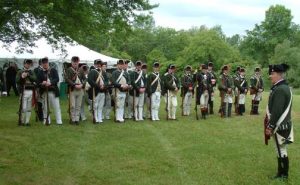 This year’s annual re-enactment of the Loyalist Landing at Adolphustown, west of Kingston, coincided with the Dominion Convention, hosted by Bay of Quinte Branch UELAC. There was a large encampment of re-enactors, as well as delegates from across Canada attending the Convention.
This year’s annual re-enactment of the Loyalist Landing at Adolphustown, west of Kingston, coincided with the Dominion Convention, hosted by Bay of Quinte Branch UELAC. There was a large encampment of re-enactors, as well as delegates from across Canada attending the Convention. 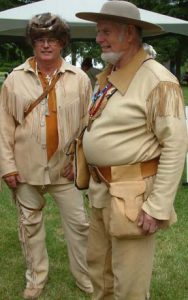 Watching some of the troops drill in the morning certainly set the mood. Visitors could also stroll through the camp area to see how the troops and their families lived 225 years ago.
Watching some of the troops drill in the morning certainly set the mood. Visitors could also stroll through the camp area to see how the troops and their families lived 225 years ago.
Re-enactors take pride in the special touches each can put on his or her uniform or costume. Right: These men may have been representing Mohawk Loyalists, or perhaps just backwoodsmen.
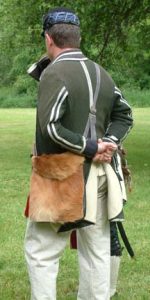
Left:This soldier’s bag made of a red fox pelt is particularly striking.
 It is authentic to find a boy among the troops, for most units had children serving with them in various capacities.
It is authentic to find a boy among the troops, for most units had children serving with them in various capacities.
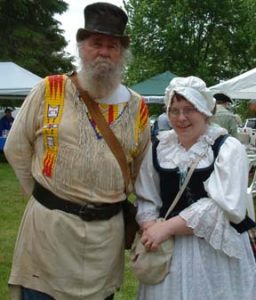
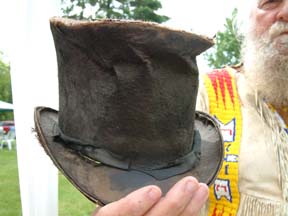
This well-dressed couple were strolling through the sales area. UELAC branches, historical societies, book sellers and branches of the Ontario Genealogical Society were all represented here, as well as some museums, and a student group with a petition asking that high schools return to the teaching of 18th and 19th-century history. The gentleman found his authentic beaver hat in a shop selling used clothing.
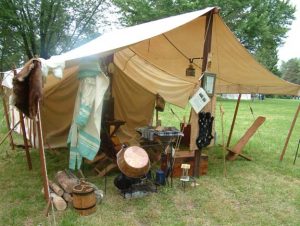
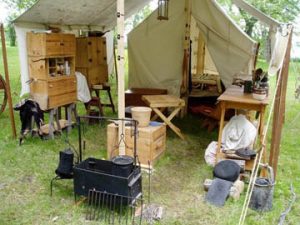
Re-enactors strive to ensure that all their camping goods are made of materials appropriate to the time of 1776-1784.
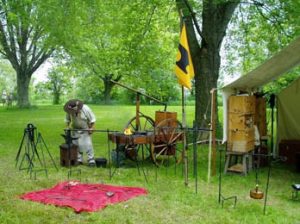
The Landing of the Loyalists
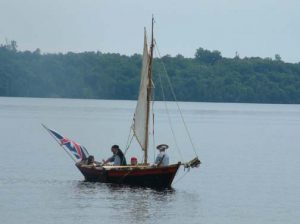 The first vessel to reach the landing site was a sailing boat. It appeared to be carrying an officer and his family.
The first vessel to reach the landing site was a sailing boat. It appeared to be carrying an officer and his family.
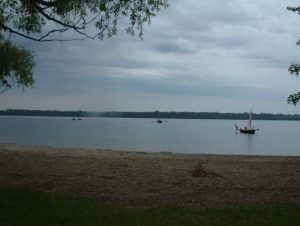 The other bateaux were rowed, with several men each taking an oar on both sides of the ship. It must have been a long, strenuous trip up-river from Sorel, where they spent the winter of 1783, leaving soon after the spring ice break-up in order to arrive at Adolphustown in June 1784.
The other bateaux were rowed, with several men each taking an oar on both sides of the ship. It must have been a long, strenuous trip up-river from Sorel, where they spent the winter of 1783, leaving soon after the spring ice break-up in order to arrive at Adolphustown in June 1784.
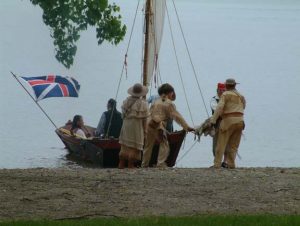
Some natives met the bateaux as they arrived.
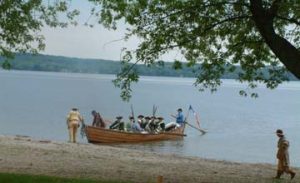
Soldiers would have landed with their weapons at the ready, since no one really knew what they were getting into.
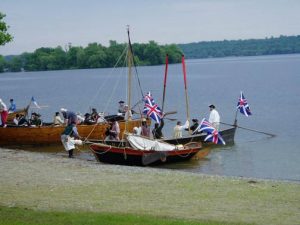
With no docks yet built, boats have to be pulled up on shore and tied to a stake.
above photo courtesy of Roy Clarke
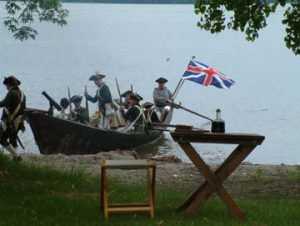 The men seem happy to end their arduous journey.
The men seem happy to end their arduous journey.
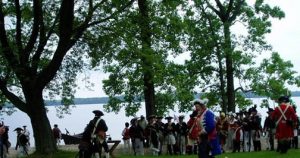 Right: The men, with their families around them if present, wait for their name to be called in the lottery for land grants.
Right: The men, with their families around them if present, wait for their name to be called in the lottery for land grants.
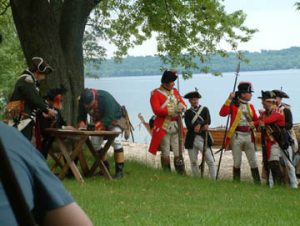
When called, the soldier has to sign or make his mark in a register book. Note the large bottle of ink on the table, for the quartermaster’s quill pen. This photo courtesy of Roy Clarke
Although assigned lots, some men never took them up, or traded them for different land. Land records can be a fertile source of information on Loyalist ancestors.
Marching to the Memorial
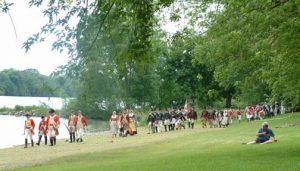 After the drawing of lots, the remainder of the re-enactors joined up with those who landed.
After the drawing of lots, the remainder of the re-enactors joined up with those who landed.
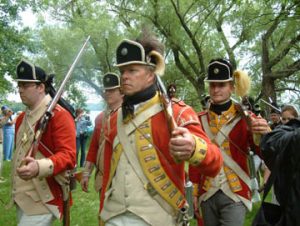 Right: Note the attention to detail on all the uniforms.
Right: Note the attention to detail on all the uniforms.
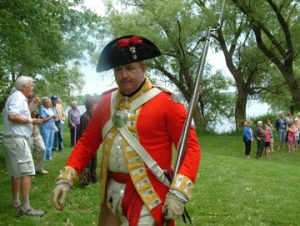
Left: This officer was clearing the audience to make way for his troops.
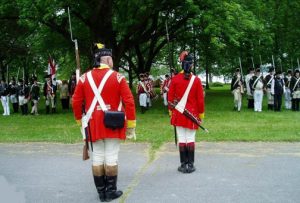
Right: “Parade Ready, sir!” reported the younger officer.
photo courtesy of Roy Clarke
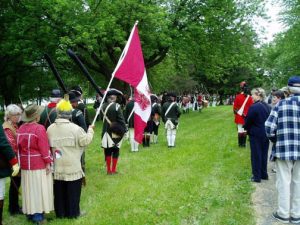
The troops begin to march up the hill toward the UEL Memorial Cemetery.
photo courtesy of Roy Clarke
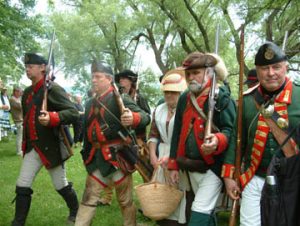
Right: Wives and children marched alongside the men.
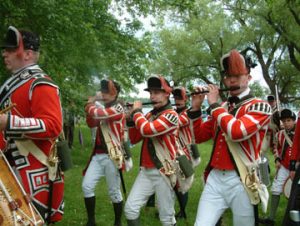 There was always music to help keep the marchers in time. Note the drummer boy.
There was always music to help keep the marchers in time. Note the drummer boy.
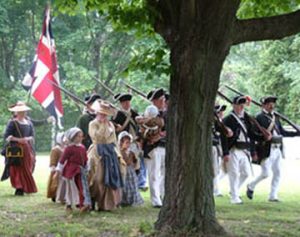
One can imagine the tears of joy and relief that would have been shed when the Loyalists reached their final destination in Canada.
Loyalist Cemetery
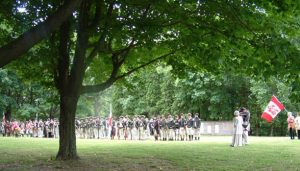 At the cemetery, the men stood grouped in the various regiments. Note the Mohawk contingent at the right.
At the cemetery, the men stood grouped in the various regiments. Note the Mohawk contingent at the right.
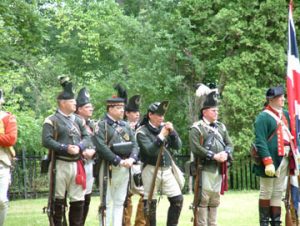
The Queen’s Rangers are distinguished by their tall caps with unique hat badges. The Scots tam is also worn, since many of this regiment were former Scots from North Carolina.
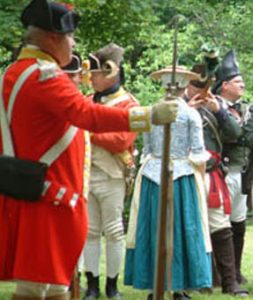
To refresh the troops after their long trip up river, women brought pails of water and a wooden ladle to drink from.
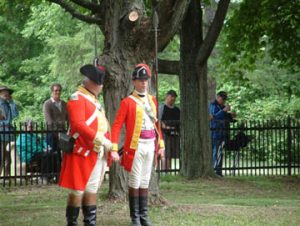
These two officers kept the ceremony moving along. Speakers explained the clothing women wore, and outlined the differences in uniform among the regiments.
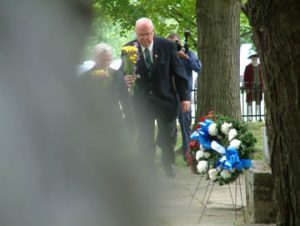 Old world mingled with 2009 at the cemetery, as representatives from each branch of the UEL Association of Canada laid a floral tribute at the UEL Memorial. Here, Myrtle Johnson of the Edward Jessup Branch, and Dean Taylor from Kingston and District Branch approach the monument.
Old world mingled with 2009 at the cemetery, as representatives from each branch of the UEL Association of Canada laid a floral tribute at the UEL Memorial. Here, Myrtle Johnson of the Edward Jessup Branch, and Dean Taylor from Kingston and District Branch approach the monument.
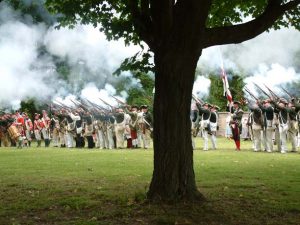
The men fired three volleys from their muskets.
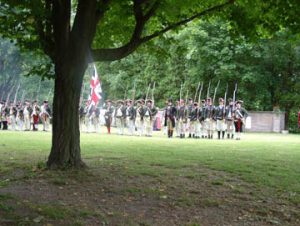
Then they were ordered to “Fix Bayonets”. Finally, the Royal Jack was raised on the flagpole, and the men sang a rousing chorus of “God Save the King”, followed by three huzzahs. The troops were then dismissed, and could mingle with the crowd.
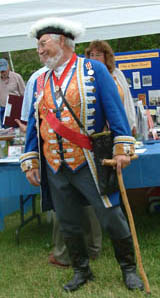
This is the crier who acted as Master of Ceremonies.
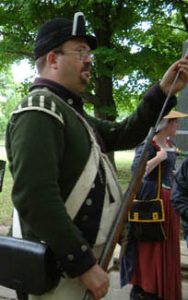
As each man left the cemetery grounds, he had to prove that all powder in his gun had been discharged, by dropping his ramrod into the musket. An empty muzzle produced a satisfying “ping” as the ramrod touched bottom.
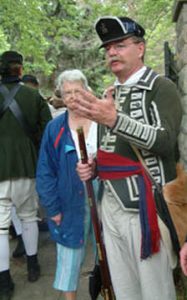
If the musket had misfired and still contained gunpowder, it produced just a dull thud, and the soldier had to dump the powder onto the ground until he could satisfy this sergeant-major.
At Ease in Camp
All Ease in Camp photos by Roy Clarke
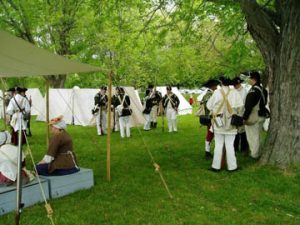
On the Sunday morning, these soldiers are just waiting at camp for their inspection.
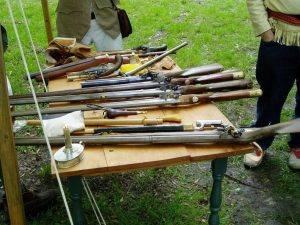
Some stored their flintlocks together, keeping them off the damp ground.
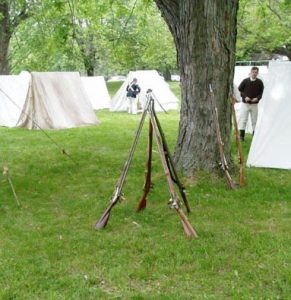
Others lean them against trees, or make a pyramid — just so long as the powder remains dry.
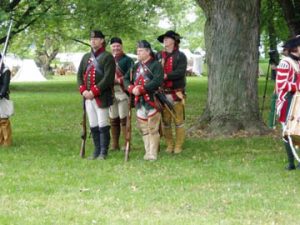 This Ranger unit is ready for inspection.
This Ranger unit is ready for inspection.
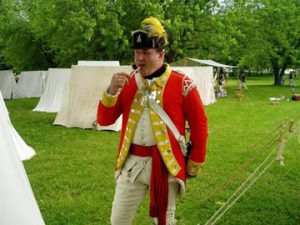
And the Sergeant-Major is getting ready for them. Even toothbrushes can be made from twigs.
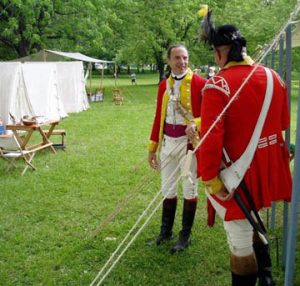
The Colonel discusses matters with the Sergeant-Major.
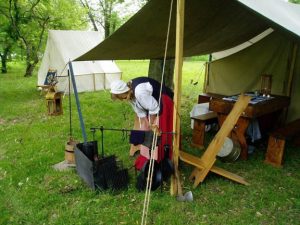
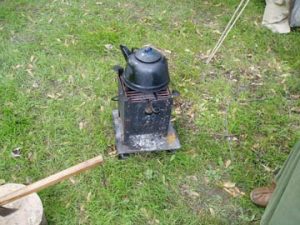
Meanwhile, the women had to tidy up their tents, and prepare for the next meal.
In 1784, all energy was from renewable resources: this camp stove takes only wood.
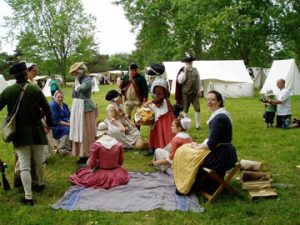
The ladies have time for a rest and a chat, while the men are occupied.
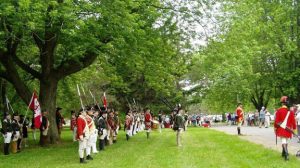
Inspecting the troops.
